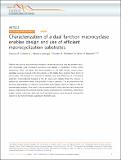Characterization of a dual function macrocyclase enables design and use of efficient macrocyclization substrates
Abstract
Peptide macrocycles are promising therapeutic molecules because they are protease resistant, structurally rigid, membrane permeable and capable of modulating protein-protein interactions. Here, we report the characterization of the dual function macrocyclase-peptidase enzyme involved in the biosynthesis of the highly toxic Amanitin toxin family of macrocycles. The enzyme first removes 10 residues from the N-terminus of a 35-residue substrate. Conformational trapping of the amino acid peptide forces the enzyme to release this intermediate rather than proceed to macrocyclization. The enzyme rebinds the 25 amino acid peptide in a different conformation and catalyzes macrocyclization of the N-terminal 8 residues. Structures of the enzyme bound to both substrates and biophysical analysis characterize the different binding modes rationalizing the mechanism. Using these insights simpler substrates with only five C-terminal residues were designed, allowing the enzyme to be more effectively exploited in biotechnology.
Citation
Melo Czekster , C , Ludewig , H , McMahon , S A & Naismith , J H 2017 , ' Characterization of a dual function macrocyclase enables design and use of efficient macrocyclization substrates ' , Nature Communications , vol. 8 , 1045 . https://doi.org/10.1038/s41467-017-00862-4
Publication
Nature Communications
Status
Peer reviewed
ISSN
2041-1723Type
Journal article
Description
H.L. is funded by the George & Stella Lee Scholarship and Criticat EPSRC. This project was also funded by the European Research Council project 339367 NCB-TNT and by the BBSRC (K015508/1). JHN is 1000 talent scholar of the Chinese Academy of Sciences at the University of Sichuan.Collections
Items in the St Andrews Research Repository are protected by copyright, with all rights reserved, unless otherwise indicated.

